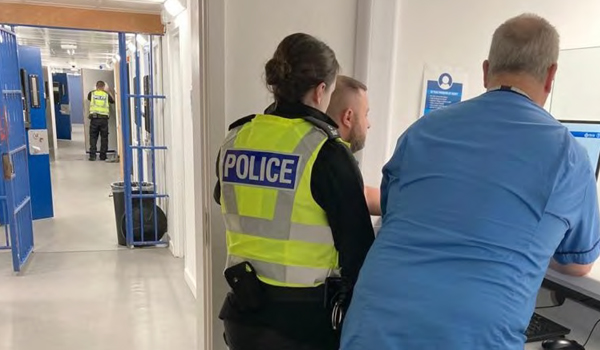Inspectors raise concerns over ‘inconsistent‘ risk assessments in custody
Detainees being held in police custody are subject to inconsistent practices when it comes to the frequency of wellbeing checks they receive, a report published on Thursday (May 30) reveals.
A review of custody records from Police Scotland stations in Ayrshire found a lack of clarity in the way custody staff were carrying out cell checks and observations of detainees.
It follows a joint inspection by HM Inspectorate of Constabulary in Scotland (HMICS) and Health Improvement Scotland (HIS) into custody facilities at police stations in Kilmarnock and Saltcoats.
From a sample of custody records examined, it was found that 88 per cent of detainees in need of increased observations were given the same level of cell check as those deemed to be of low risk.
HM Chief Inspector of Constabulary in Scotland, Craig Naylor, has called on Police Scotland to ensure that custody staff have a clear understanding of what response is required for each of the defined observation levels and that these are applied consistently.
He said: “Our review of Police Scotland National Custody System records highlighted issues regarding disparity between some of the risk assessments undertaken and the corresponding care plans put in place.
“During the booking-in process, a risk assessment is carried out for all new arrivals to police custody.
“Effective risk assessment is vital to ensure that detainees can be managed and cared for appropriately.”
Under existing Police Scotland procedures detainees undergo risk assessments that see them placed on corresponding observation levels graded from the lowest, Level 1, to the highest, Level 4.
At Level 1, detainees are checked in their cell and must give a verbal response at least once every hour for the first six hours in custody, and thereafter hourly visits are still undertaken by custody staff, but the detainee need not be woken for a verbal response for up to three hours.
Individuals deemed to be at the highest risk, are under close proximity observation by staff who are either in the custody cell with them or watching from an open cell door.
Mr Naylor said: “It was notable that whilst 54 per cent of the sample we examined were recorded as high risk, a considerable majority of these were placed on standard 60-minute observations.
“While risk was mitigated by use of enhanced CCTV observations, the recording of risk and care plans was confusing and inconsistent.”
Inspectors from HMICS and HIS made an unannounced visit to the police custody centres at Saltcoats and Kilmarnock in February this year.
Interviews were conducted with detainees and staff during the inspection and an assessment was made of the premises, including the quality of the cells, key processes and procedures, including the provision of healthcare.
At both Saltcoats and Kilmarnock, inspectors found the custody centres to be well maintained and in a generally good physical condition, with prisoner property arrangements found to be in very good order.
All cells were clean, washing facilities were good, and there were adequate staffing levels which included a good balance of male and female custody staff.
The layout of both facilities, particularly in Saltcoats, allowed for the segregation of individuals away from other detainees, however this was not routinely employed other than when children or young people were being held.
There were ceiling mounted CCTV facilities in all cells within both police stations although at Kilmarnock, there was no CCTV in ten cells routinely used in the adjoining sheriff court building when extra capacity was needed at weekends.
Detainees at Kilmarnock told inspectors they had been treated very well, by “efficient” and “respectful” custody staff.
However issues relating to the recording of medication provision and the storage of controlled drugs were among several areas of concern raised by the review team.
Mr Naylor said: “This report, similar to our recent joint inspection of custody in Fife, highlights our concerns regarding a lack of consistency in the recording of information on the National Custody System.
“Whilst some aspects of custody centre operations were recorded well, such as hand-over records, the recording of medication provision was found to be inconsistent.”
The inspection team noted there was no clinical supervision in place for nursing staff providing care for detainees, though senior Forensic Medical Examiners were routinely available for advice and to discuss complex cases.
The team also found instances where individuals were held in custody beyond their expected release time and made a recommendation for this practice to be addressed.
Mr Naylor said: “Our examination of 46 records held on the National Custody System found that on four occasions, after a decision to release a detainee had been recorded, the detainee was held for a further period of between 8 and 12 hours before they left custody.
“In three instances the delay possibly related to the detainee being intoxicated but there was little information to explain why a delay in release was necessary.
“Police Scotland should review compliance with policy relating to the delay of release following a disposal decision being made and ensure that staff adhere to this.”
Security issues at the police stations housing the custody centres were also raised in the 55-page-long inspection report.
Police custody is a high-risk area of policing business and has been subject to considerable scrutiny by HMICS since Police Scotland was established.
The ‘HMICS Custody Inspection Report Ayrshire’ makes eight recommendations for Police Scotland and the NHS.
It also listed five further areas where it would like to see improvement, including that both custody centres should routinely consider the use of separate cell corridors for gender-based segregation to improve privacy.
Mr Naylor added: “While the recommendations we have outlined in this report have specific relevance for Kilmarnock and Saltcoats custody centres, we recognise that some of these will be equally applicable to other custody centres across Scotland and should be considered in future improvement planning.”


